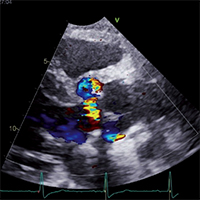Echocardiographic evaluation of paravalvular aortic regurgitation of a patient with recurrent aortic valve replacements

All claims expressed in this article are solely those of the authors and do not necessarily represent those of their affiliated organizations, or those of the publisher, the editors and the reviewers. Any product that may be evaluated in this article or claim that may be made by its manufacturer is not guaranteed or endorsed by the publisher.
Authors
Paravalvular regurgitation (PVR) is a serious complication after surgical valve replacement. Echocardiography is the gold standard technique to assess the severity of PVR with an integrated approach. A 48-year-old male underwent aortic valve replacement due to infective endocarditis (IE). During in-hospital cardiac rehabilitation after a redo surgery for a new IE three years later, an echo-free anterior space around the valve with several PVRs through transthoracic echocardiography (TTE) was identified. On transesophageal echocardiography (TOE) a double PVR (anterior and posterior) with abscessual cavity was detected. The patient’s conditions worsened within six months with hemodynamic instability: a massive PVR due to a large abscess cavity next to the right cusp was confirmed by TTE and TOE and a third surgery was carried out. On the third admission at our Rehabilitation Unit the echo features were normal. Patient did not report any cardiovascular symptoms at 1 year follow-up.
How to Cite

This work is licensed under a Creative Commons Attribution-NonCommercial 4.0 International License.






